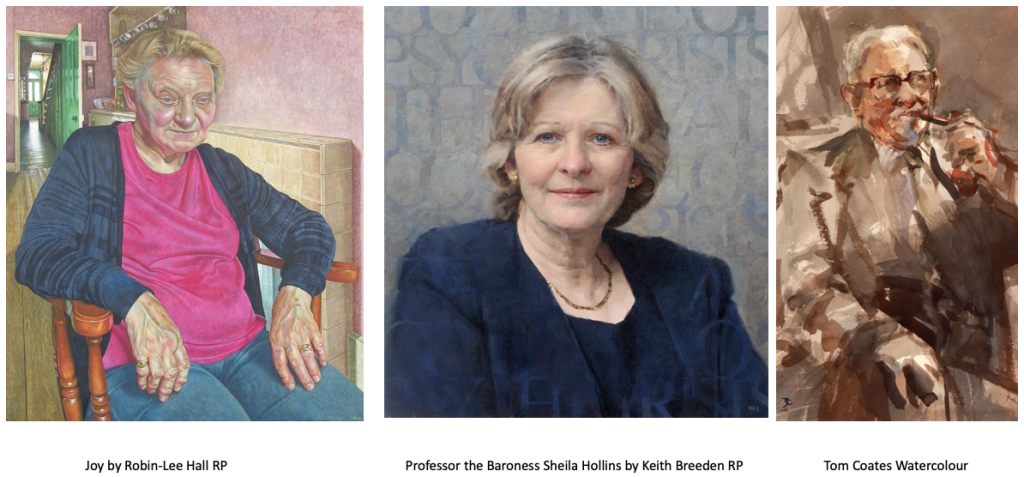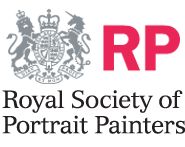In what Portrait Painters Need to Know when Working to Commission Annabel Elton, Head of Portrait Commissions at the Federation of British Artists gives hints and tips for artists working on Portrait Commissions.
This series of videos, filmed at Heatherley School of Fine Art, focuses on advice for artists when working on portrait commissions.
This chapter focuses on Pricing and Money.
Other videos in the series include:
- How to Get Yourself Seen: The Four Curated Options
- How to Get Yourself Seen: Marketing & Promotion
- The Client’s Perspective
- Communication: Keeping a Client Happy
This video focuses on pricing, and how to build a pricing structure when working to commission.
Client perspective
They’ve looked around the exhibition. They’ve looked around your website, they’ve chosen you. And they’re going to ask:
- Can I afford it?
- How much does it cost?
From your point of view how did you get to a pricing point? It’s not easy.
Pricing progression
Over a career, this is a progression. When you’re starting out, you need to build a portfolio of work. As such:
- Pricing to sell – You just need to get the work out there.
- Pricing to make a living – You start to get the commissions in, and you’re serious about this
- Pricing to keep waiting lists under control -You start to have to manage waiting lists and when you feel the commissions coming in, that’s a good time just to edge your prices up
The practical element
Different artists have different techniques and different techniques take different amounts of times to produce.

Looking at these three above, the number of hours that have gone into them will be very different. Tom Coates will have done this watercolour in a matter of hours. But Keith Breeden will use 26 layers of glazes, typically for his oil paintings so it would take much more time, or somebody like Robin-Lee Hall working in an Egg Tempera with those minute brushstrokes.
Part of pricing, particularly at the early stages has to be:
- How many hours does it take?
- Can I afford to do this?
Pricing isn’t a science, it is an art form. You kind of put a lot of ingredients into the mix, shake it up, try something, see if it feels right. That’s until you feel comfortable. Because once you’ve published a price, it’s out there and it’s hard to retract from it.
It’s much easier to go up than it is to come down. Publicly retreating on prices doesn’t look good.
As I mentioned before, creating a portfolio for marketing would be downward pressure. Pounds
External factors
- What’s everyone else charging?
- Have you sold before?
- What’s your benchmark?
- And who are you selling to?
Because if you’re selling to people, without a lot of expendable money, then you can’t charge more than they can pay. But if you attract a very wealthy clientele, then there’s a bit more room there. As soon as you feel the pressure work maybe it’s time to go up a bit.
Other things bear in mind:
- If you’re working with an agent you need to make an allowance for commission.
- Professional artists like to keep a level price across all the platforms.
- VAT registration.
- VAT is an awful bore and is not just expensive, It’s very time consuming to administer. But if you hit that, you need to price that in. Our artists usually price it on top so it is £x plus VAT, but if you get near VAT you do need to be clear about what’s going on
Expenses and extras
You can’t really include expenses in a portrait as you don’t know what they’re going to be. Sometimes the frame is part of the work so it does get included
But, if it’s something that the client has a part in or adds on, they might want a very elaborate hand carved hand gilded frame with thousands of pounds. Or they might want a simple wooden frame for much less. That is a separate additional item.
The same applies with any travel or accommodation. Just keep the know-ables within your fee structure, and then be clear about it with the client.
The client has come to you. They know roughly what you’re about what are going to be the questions they’re going to ask next, when they’re getting quite close to commissioning. They do need to know what you’re going to charge.
They need to feel safe with the decisions they’re making. If they suddenly decide to add a cat or dog house or something complex, they need to know how much or whether you’re going to add to your pricing for that.
And they don’t want to embarrass themselves by diving in something they can’t afford. You do need to give information so people feel safe.
And I think we’ve gone through but things are not included such as extra people. Some artists feel that extra people are actually quite helpful because you have a lot of fingers in a space, you pay less attention to the head, and it becomes more of a conversation piece so they don’t add much perks to the person.
Other artists think, Ah, well, that’s two portraits and a portrait of the relationship between two people. If any of those things goes wrong, well, I got to start again. And so the amount extra per figure goes up.
The difference is between 10% and 75% extra would be rules of thumb, but as you know, as artists, there are no rules for Artists, everyone’s different.
Payment Stages.
Very often, an artist will take a deposit. And that keeps the relationship safe. You know, the client is serious about completing the journey, it helps with the cash flow and it looks professional.
But for a lot of artists, this doesn’t work out. They much prefer a more fluid, more personal relationship. And you either take it or leave it on completion. Those decisions are very personal to the artists as to how you work on this front.
Always give a quote; it’s important to manage expectations. Once you’ve agreed with your client, what the parameters are, what you’re going to do, it’s good to get this in writing:-what you’re going to do and how much it’s going to cost, so that everybody knows what’s going to happen and the no misplaced expectations.
Handling a deadline
Clients are always interested in timing. It is not always make or break but they often will put a completion date upfront really early. So, say, if you think you’re going to take six months, it’s probably wise to say seven in case you’re ill or go on holiday or something else jumps in. So the client doesn’t feel that they’re unimportant and slipping in the queue.
Collaboration
The other interesting one is how much do they get involved. Because, if you’re not experienced with commissions, you may not know how it feels to have somebody feeding back to you about something that they are a co-participant in.
Some artists actually won’t let their client see that portrait until it’s finished. Partly as it is not finished and therefore any comments not relevant, but often because they get too concerned about pleasing the client that it throws the whole portrait off.
That’s a personal thing to think about how much you’re going to let the Client be involved along the journey. Too much client involvement over the journey, I feel can be very complicated and can make for a bit of a camel.
It doesn’t mean you don’t collaborate. It’s important to be engaged all the way. But it’s something that you need to be aware that you’re managing.
The Sign Off and final payment
And then the sign off. Signing off with an individual is easy. Very often it’s sending over a JPEG for approval. If everybody’s happy, which they usually are, it’s the bill and then you deliver the work.
But if you’re dealing with an institution, it’s not always very clear.
Whose sign off is it? Is it the sitter? Is it the person organising the commission? Is it a committee or is it the head of the organisation?
So it’s good to identify that quite early on and what the procedures are for getting the work approved .
The final payment is usually due on approval.
Annabel Elton is Head of Portrait Commissions at the Federation of British Artists.
Discover other posts from this series:

